
The world of the crustaceans is a world of bizarre shapes and adaptations. This group of animals is probably best known for their hard outer shell. As the animal grows, this shell must be removed and discarded. Once this takes place, the new shell takes time to harden. During this period, the animal is without its primary means of protection and vulnerable to attack from predators. But they have an impressive arsenal of weapons at their disposal. The claw of many crustaceans is capable of exerting hundreds of pounds of pressure. Some even have the unique ability to produce a deafening miniature sonic boom with which they stun their prey. The mantis shrimp can even break the glass of an aquarium or split a man's thumb to the bone with one strike. But in spite of their impressive armor and fierce weaponry, the crustaceans do occasionally meet their match. The teeth of the triggerfish and the beak of the octopus can crack through the toughest shells of crabs and lobsters, making an enjoyable meal. Below is a listing of some of the more common crustaceans to be found on the coral reef.

These rather bizarre looking creatures get their name from the triangular or arrowhead shape of their bodies. Their long legs give them a spider-like appearance. They can reach a leg span of about six inches, and are notorious for pulling feather duster worms out of their tubes with their long claws.

The hermit crab is a curious species that carries its home around on its back. Because the crab's abdomen is soft and vulnerable, its uses discarded snail shells to protect itself. As the crab grows larger, it must continually seek out larger shells. Hermit crabs are adept scavengers, and will feed on just about anything they find.

The purple shore crab is commonly found on the open rocky seashores of the pacific coast of North America. It has a purple and red shell with a white underbelly, and grows to about 2 inches in length. This small crab can be seen scavenging the seashore where it feeds on algae and dead animal matter.
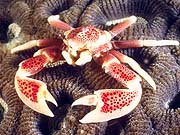
The anemone crab is a small, colorful crab with a porcelain-like shell. Like the clownfish, this crab has developed an immunity to anemone stings. This crab is usually found within the stinging tentacles of a number of anemone species where it uses its large well-developed claws to keep clownfish from stealing its home.
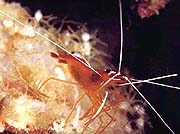
The cleaner shrimp gets its name from its behavior of cleaning parasites and damaged scales from many species of fish, including moray eels and large groupers. Although it would make a tasty morsel, the shrimp is allowed to clean inside the fishes' mouth in complete safety with no danger of being eaten.
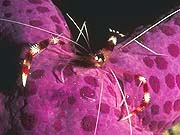
The banded coral shrimp is distinguished by its colorful red or purple bands and its large claws. This shrimp is very popular among marine aquarium hobbyists. It is nocturnal, and scavenges the coral reef at night in search of scraps of food. They will also occasionally clean parasites from fish.
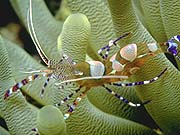
The anemone shrimp is a small transparent species that is often found living within the stinging tentacles of sea anemones. They usually grow to about one inch in length. Anemone shrimps can sometimes be found sharing a large anemone with one or more clownfish or anemone crabs, where they feed on scraps.
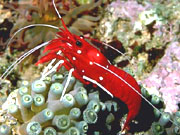
The blood shrimp gets its name from its dark blood-red color. The red color appears black underwater, helping this shrimp to hide from predators. The bright colors of this species make it a desirable but expensive addition to the home aquarium. They are found in the waters of the Indian ocean.
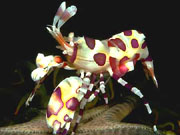
The harlequin shrimp is a rather bizarre-looking creature. But even more bizarre than its looks is the shrimp's diet. The harlequin feeds solely on starfish. It will flip the starfish over and feed on its vulnerable underside. The bright colored spots help the shrimp to blend in with the background.
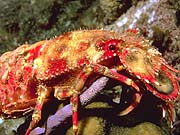
This species of lobster is characterized by the fact that is has no antennae. Instead it has hard well-developed plates around its head. The slipper lobster uses these to dig through the sand in search of food. It is a scavenger and feeds on small crustaceans, worms, and just about anything else it can find.
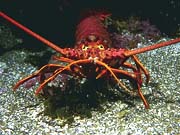
The spiny lobster gets its name from the large long spines protruding from the front of its shell. They vary in color from pale almost white, to deep orange, to dark red and brown. These lobsters occasionally participate in mass migrations where a lead lobster will be followed by thousands of others marching in a single file line.
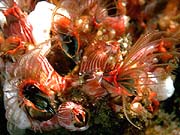
The barnacle is a very common site around the ocean. They are frequently seen in clusters attached to boats, docks, and even whales. Barnacles are filter feeders. They feed on plankton and other floating debris and spend their entire lives permanently attached to one spot.
Sponges & Sea Squirts | Corals & Anemones | Sea Worms | Echinoderms
Crustaceans | Mollusks | Coral Reef Fishes | Unusual Reef Fishes
Sharks & Rays | Marine Reptiles | Marine Mammals